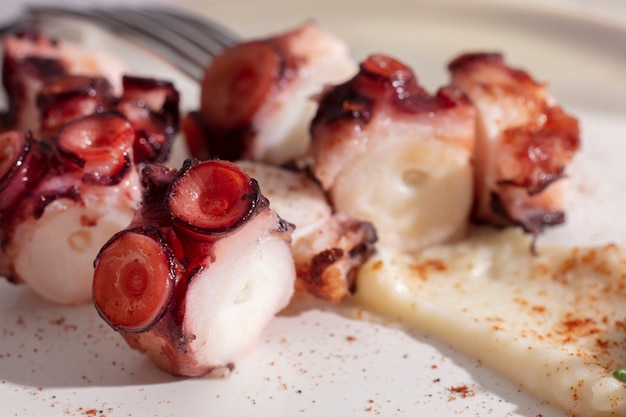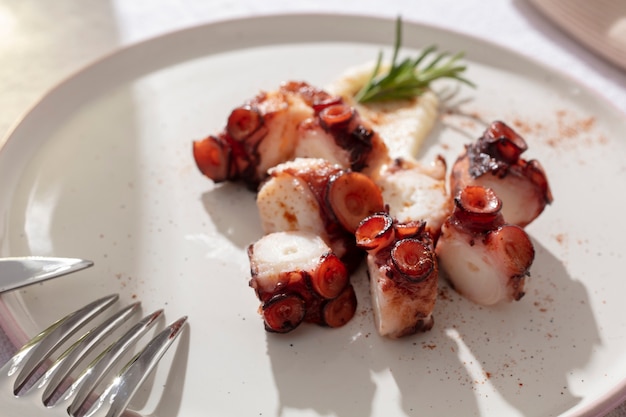Ah, octopus. It's not your everyday seafood, that's for sure. It's a bit of a culinary challenge, but one that's utterly rewarding when done right. Imagine: melt-in-your-mouth tenderness, a dramatic colour transformation as it cooks, and a flavour that's just... well, you'll know it when you taste it.
Now, let's get real. Octopus can be a bit of a tricky customer when it comes to cooking time. Get it wrong, and you'll end up with something tough and rubbery. Get it right, and you'll be rewarded with a dish that's simply divine.
I've been cooking octopus for years now, and I've learned a few things along the way. I'm going to share all my tips and tricks with you today. So put the kettle on, grab a comfy chair, and let's dive into the world of octopus cooking.
(Part 1) The Hunt for the Perfect Octopus

First things first, you need to find your octopus. You can usually snag fresh octopus at your local fishmonger, but be sure to choose a reputable one. I've had a few less-than-stellar experiences in the past, so always ask about the source and freshness.
Freshness is Key
When choosing your octopus, here's what to look for:
Sparkling Eyes: A fresh octopus will have bright, shiny eyes. If they're cloudy or sunken, it's best to move on.
Firm and Smooth Skin: The skin should be firm and smooth to the touch. If it's sticky or slimy, it's a sign that it's not so fresh.
Springy Flesh: Give it a gentle squeeze. The flesh should feel firm and springy, not soft or flabby.
Rich Colour: A fresh octopus should have a deep, reddish-brown colour. If it's pale or faded, it's likely past its prime.
Once you've got your octopus, you're ready to start cooking. But before we get to the actual cooking process, let's talk about preparing your octopus for the best possible outcome.
(Part 2) Prepping Your Octopus: The Key to Tenderness

Preparing your octopus is an essential step. It's not just about cleaning it; it's about getting it ready to cook perfectly.
The Tenderizing Trick
First up, you'll need to tenderize the octopus. Now, this is a step that some people skip, but I swear by it. Tenderizing your octopus will make it a lot more palatable, turning that chewy texture into a delightful melt-in-your-mouth experience. There are a few methods you can use:
Tapping: This is the simplest method. Simply take a mallet or rolling pin and gently tap the octopus all over. This will break down the muscle fibres, making it more tender.
Salt Brine: This is a classic method that involves soaking the octopus in a saltwater brine for a few hours. This helps to draw out moisture and make the octopus more tender.
Freezing: This is another popular method. Simply freeze the octopus for a few hours. This will help to break down the muscle fibres, making it more tender.
Cleaning Up: A Quick and Easy Process
Once you've tenderized your octopus, it's time to clean it. This is a quick and easy process:
Removing the Beak: This is a small, sharp beak found at the center of the octopus's head. You can remove it by simply cutting it off with a sharp knife.
Cleaning the Gut: You'll find the gut inside the octopus's head. You can remove it by cutting it open and cleaning it out with running water.
Washing the Octopus: Once you've removed the beak and the gut, wash the octopus thoroughly with cold water.
(Part 3) The Octopus Cooking Methods: A culinary adventure

Now, the moment you've all been waiting for – the cooking. There are several different methods you can use to cook octopus. Here's a breakdown of some of the most popular ones:
1. Poaching: A Gentle Approach
The Basics: Poaching is a gentle cooking method that involves simmering the octopus in water. This is a great way to cook octopus if you're looking for a tender and delicate flavour.
The Steps:
Bring a large pot of water to a simmer.
Add the octopus and simmer for 30 minutes.
Remove the octopus from the water and let it cool.
The Timing: The cooking time for octopus will vary depending on its size. As a general rule, a 1kg octopus will take about 30 minutes to poach. It's always best to err on the side of undercooking, as you can always cook it a little longer if needed.
2. Braising: Rich Flavours and Tender Textures
The Basics: Braising is a slow and moist cooking method that involves searing the octopus first, then simmering it in liquid. This is a great way to cook octopus if you're looking for a rich and flavourful dish.
The Steps:
Heat a large skillet over medium-high heat.
Add a little oil to the skillet and sear the octopus on all sides. This step will give your octopus a beautiful crust and lock in the flavour.
Transfer the octopus to a dutch oven or casserole dish.
Add enough liquid to cover the octopus, such as wine, broth, or tomato sauce.
Bring the liquid to a simmer and cover the dish.
Braise the octopus until it is tender, about 2-3 hours.
The Timing: The braising time will depend on the size of your octopus and the liquid you are using. A good rule of thumb is to cook it until it is tender enough to shred with a fork.
3. Grilling: A Smoky and Charred Delight
The Basics: Grilling is a great way to cook octopus if you're looking for a smoky and chargrilled flavour.
The Steps:
Preheat your grill to medium-high heat.
Season the octopus with salt and pepper.
Grill the octopus for 5-7 minutes per side, or until it is cooked through.
Let the octopus rest for a few minutes before slicing and serving.
The Timing: The grilling time will vary depending on the size and thickness of your octopus.
4. Roasting: Crispy and Flavorful
The Basics: Roasting is a great way to cook octopus if you're looking for a crispy and flavorful dish.
The Steps:
Preheat your oven to 400°F (200°C).
Season the octopus with salt, pepper, and any other desired spices.
Place the octopus on a baking sheet and roast for 30-45 minutes, or until it is cooked through.
Let the octopus rest for a few minutes before slicing and serving.
The Timing: The roasting time will vary depending on the size and thickness of your octopus.
5. Baking: Tender and Delicate
The Basics: Baking is another way to achieve a tender and flavorful octopus.
The Steps:
Preheat your oven to 350°F (175°C).
Season the octopus with salt, pepper, and any other desired spices.
Place the octopus in a baking dish and add a little liquid, such as broth or wine.
Cover the dish with foil and bake for 1-2 hours, or until the octopus is tender.
The Timing: The baking time will depend on the size and thickness of your octopus.
The doneness test: How to Know When Your Octopus is Ready
But how do you know when your octopus is cooked? Well, there are a few things to look for:
Colour: The octopus will turn a reddish-purple color when it’s cooked. This is a beautiful visual cue that signals the octopus is cooked through.
Texture: The octopus should be firm and bouncy to the touch. It shouldn't feel flabby or mushy.
Ease of Piercing: When the octopus is cooked, it should be easy to pierce with a fork. This means the muscle fibres have relaxed and softened.
(Part 4) The Octopus Colour Change: A Culinary Spectacle
You might notice that your octopus changes colour as it cooks. This is a normal and fascinating phenomenon.
From Red to Purple: A Colour Transformation
When the octopus is raw, it's a reddish-brown colour. As it cooks, the pigments in its skin react with heat, causing it to turn a vibrant reddish-purple. This is a beautiful sight to see, and it’s a sure sign that your octopus is cooking nicely.
The Science Behind It: Chromatophores
The colour change is due to the presence of special pigment-containing cells called chromatophores. These cells contain tiny sacs of pigment that can be expanded or contracted by muscles, causing the octopus to change colour.
A Visual Delight: Appreciate the Beauty
So next time you’re cooking octopus, take a moment to appreciate the colour change. It’s a testament to the amazing properties of this unique creature.
(Part 5) Flavouring Your Octopus: A Canvas for Creativity
Now, let’s talk about flavour. Octopus is a blank canvas for flavour, and you can really get creative with how you season it.
Classic Flavors: Tried and True
Here are some classic flavours that work well with octopus:
Lemon: A squeeze of lemon juice can add a bright and refreshing flavour, cutting through the richness of the octopus.
Garlic: A few cloves of garlic can add a pungent and savory flavour, complementing the octopus beautifully.
Olive Oil: A drizzle of olive oil can help to enhance the flavour and create a rich texture, making your octopus taste even better.
Herbs: Herbs like parsley, oregano, and thyme can add a fragrant and herbaceous flavour, adding a touch of freshness and complexity.
Chillies: A pinch of chilli flakes can add a touch of heat, giving your octopus a bit of a kick.
Beyond the Basics: Experiment and Discover
Don’t be afraid to experiment with different flavours. You can add spices like cumin, paprika, or turmeric. You can also add ingredients like tomatoes, onions, or potatoes.
A Final Tip: Marinating for Extra Flavour
If you want to add extra flavour to your octopus, try marinating it before you cook it. A marinade can help to tenderize the octopus and infuse it with delicious flavour.
(Part 6) Serving Your Octopus: Endless Possibilities
Now, let's talk about serving your octopus. This is where things get really fun! There are endless possibilities when it comes to serving this amazing ingredient.
A Variety of Styles: From Appetizers to Main Courses
You can serve octopus in a variety of ways:
Salads: Octopus is delicious in salads. Try a Greek salad with octopus, tomatoes, olives, and feta cheese, or a salad with octopus, avocado, and mango.
Appetizers: Octopus can also be served as an appetizer. Try octopus carpaccio, octopus skewers, or octopus salad.
Main Courses: Octopus is a fantastic main course ingredient. Try octopus paella, octopus stew, or grilled octopus with roasted vegetables.
pasta dishes: Octopus is also delicious in pasta dishes. Try a pasta dish with octopus, tomatoes, garlic, and chili flakes.
Soups: Octopus can also be used in soups. Try an octopus and chickpea soup, or an octopus and potato soup.
A Word on Presentation: Make it Look as Good as It Tastes
Remember that presentation is everything! When you’re serving octopus, make sure to slice it nicely and arrange it attractively. It should look as good as it tastes.
(Part 7) Octopus cooking tips: Pro Tricks for Success
I’ve learned a few tips and tricks over the years that have helped me to cook octopus perfectly.
1. Don't Overcook it: The Key to Tenderness
Octopus is very delicate and can easily be overcooked. If you cook it for too long, it will become tough and rubbery. So, it’s important to cook it just until it’s tender.
2. Tenderize it: The Secret to a Soft Bite
As I mentioned before, tenderizing the octopus before you cook it is essential. You can do this by tapping it with a mallet, soaking it in a saltwater brine, or freezing it.
3. slow cooking is Key: Patience is a Virtue
Octopus is a slow-cooking meat, so don't rush the process. Give it plenty of time to cook through and become tender.
4. Keep it Moist: A Crucial Element for Tenderness
Octopus is best cooked in a moist environment, so make sure you use enough liquid when you’re poaching, braising, or baking it.
5. Cool it Down: Letting the Octopus Rest
Once your octopus is cooked, let it cool down completely before you slice and serve it. This will help to make it more tender.
6. Seasoning and Flavour: Experiment and Discover
Don’t be afraid to experiment with different flavours when you’re cooking octopus. It's a blank canvas for your culinary creativity.
7. Freshness Matters: The Foundation of Deliciousness
The best octopus is the freshest octopus, so always make sure to buy it from a reputable source.
8. Don't Be Afraid to Experiment: Learn and Grow
Cooking octopus can be a bit of a learning curve, but don’t be afraid to experiment! The more you cook it, the better you’ll get at it.
(Part 8) FAQs: Your Questions Answered
1. How long should I cook an octopus for?
The cooking time for octopus will depend on its size. A good rule of thumb is to cook it for 30 minutes per kilogram. However, keep in mind that this is just a general guideline. Always check the doneness by using the colour, texture, and piercing tests I mentioned earlier.
2. How do I know when an octopus is cooked?
The octopus will turn a reddish-purple color when it’s cooked. It should also be firm and bouncy to the touch and easy to pierce with a fork.
3. What if I overcook my octopus?
If you overcook your octopus, it will become tough and rubbery. There’s not much you can do to salvage it, so it’s best to avoid overcooking it in the first place. Remember, it's always better to undercook slightly and cook it a bit longer if needed.
4. Can I freeze octopus?
Yes, you can freeze octopus. In fact, freezing can actually help to tenderize it. However, it's important to defrost it slowly in the refrigerator before cooking.
5. What are some good octopus recipes?
There are endless possibilities when it comes to octopus recipes. Try a Greek salad with octopus, tomatoes, olives, and feta cheese, or a pasta dish with octopus, tomatoes, garlic, and chili flakes. There are also many great recipes available online and in cookbooks.
(Part 9) Conclusion: Embrace the Challenge
I hope this guide has helped you to understand the basics of cooking octopus. It’s a unique and rewarding ingredient that can add a touch of sophistication to any dish.
Remember, patience and practice are key. Just like any other cooking skill, it takes time and effort to perfect.
So, go out there and give octopus cooking a try. You won’t regret it!
(Part 10) A Final Note: Reach Out for Help
One last tip: Don’t be afraid to ask for help. If you’re unsure about anything, ask your fishmonger, a friend who knows about octopus cooking, or even search online for some helpful resources.
Happy cooking, everyone!
Everyone is watching

Prime Rib Roast Cooking Time Chart: Per Pound Guide
Cooking TipsPrime rib roast. Just the name conjures images of lavish dinners, crackling fires, and hearty laughter. It’s ...

How Long to Bake Potatoes in the Oven (Perfect Every Time)
Cooking TipsBaked potatoes are a staple in my kitchen. They're incredibly versatile, delicious, and surprisingly easy to m...

Perfect Rice Every Time: The Ultimate Guide to Cooking Rice
Cooking TipsAs a self-proclaimed foodie, I've always been a bit obsessed with rice. It's the foundation of countless cuisi...

The Ultimate Guide to Cooking Asparagus: Tips, Techniques, and Recipes
Cooking TipsAsparagus. The mere mention of this spring delicacy conjures up images of vibrant green spears, crisp and burs...

Ultimate Guide to Cooking the Perfect Thanksgiving Turkey
Cooking TipsThanksgiving. Just the word conjures up images of overflowing tables laden with delicious food, the scent of r...
